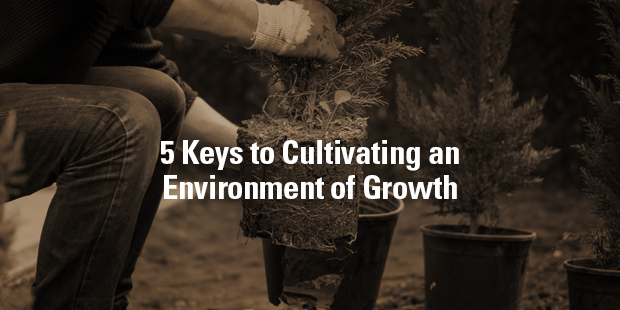
5 Keys to Cultivating an Environment of Growth
When it comes to faith, it’s our job as leaders to make what is intangible and supernatural, practical and assessable. That’s not easy.
In a rapidly changing culture where the Bible is an option to as many as it is the inerrant Word of God, it’s challenging to create an environment of abiding faith in Jesus.
An environment that cultivates faith is rooted in the gospel, evangelism, and prayer. Ultimately it champions and results in life change.
The idea is to create an environment where people in all stages of a relationship with God, sense a grace-filled invitation to pursue faith. From agnostic (even atheist) to those who have been to church but have become disenfranchised and have fallen away.
It also includes mature Christians who have faith but desire greater faith. For example, maybe moving their prayer life from routine to believing for a miracle. Again, it’s not easy to reach this diverse of a crowd all at the same time.
The process of spiritual understanding and maturation is not a fast one. We lead toward “decisions” and that is good, but in the end, process and practices grow faith one day at a time over a lifetime.
It’s not wise to try to shortcut this process. That’s not a lack of evangelistic zeal; it’s a realization that faith can’t be rushed. Allow the Holy Spirit to move and give him the time and space required.
Cultivating a faith environment:
1) Communicate hope.
Developing faith is difficult for people in a culture that does not intuitively trust God or is at least inconsistent in their trust of God.
Let them know that even though you fully believe and trust God, there are times of uncertainty. Yet at the same time, you know that God is present, active, faithful and loves you unconditionally.
This helps establish your credibility to then communicate your hope and faith in their better future.
Essentially, your faith rubs off! It’s contagious. They see you as real and begin to believe they can experience hope for a better future too. (This is obviously not limited to a Sunday morning worship experience.)
2) Demonstrate acceptance and lean into the Gospel.
Faith is at the center of the four gospel accounts, along with love.
One of the most recognizable verses of all time is John 3:16..
For God so loved the world that he gave his one and only Son, that whoever believes in him shall not perish but have eternal life.
The foundation of the gospel is unconditional love. Only faith (belief) is required.
The next verse is not quoted nearly as often but is vitally instructive in this process.
For God did not send his Son into the world to condemn the world, but to save the world through him.
John 3:17
God accepts each person as they are, and it’s our great privilege and responsibility to do the same in our churches. It’s only after initially trusting God that there is an appropriate challenge to grow in their faith.
3) Make faith challenges doable.
For those that experience the miraculous early on in their faith development, that’s great, but that may not be the pattern over decades to come. Therefore, a consistent and steady pursuit of faith is often best over the long haul.
What can you believe God will do? That’s a helpful question. That’s not the same as, “What do you believe God can do?” The first reveals a person’s faith, the second reveals a person’s understanding of who God is.
You know God can do anything, because of your knowledge and relationship with Him. In short, your maturity. There are many in your church who cannot yet grasp this concept.
For example, can they trust Him with their marriage, their money, or their job? Anyone of those can be overwhelming.
This isn’t about dumbing down God to our level; it’s about helping believers rise to understand and embrace the fullness of God.
4) Emphasize do’s over don’ts.
It’s true that the Scriptures contain numerous things we should not do, and we can’t ignore that instruction. However, a steady diet of mostly “thou shall not’s”, defeats faith and discourages progress.
First, in the natural realm, the person gives up on their ability to live up to the standards of a growing faith and Christian maturity.
Second, they can become discouraged that a Christian lifestyle is just not achievable, even with God’s help.
A balance of admonition and encouragement is important, but the presence and power of the Holy Spirit has a way of increasing what is pleasing to God, and slowly eliminating the things that break His heart.
5) Tell stories that inspire faith.
Few things are more inspiring than real stories of people engaging their faith.
Tell stories and show video interviews of people trusting God with their money, trusting God with their time (serving), and of course salvation.
Baptism stories are among my favorites. In one minute, you catch a glimpse of someone’s early faith story. There is nothing more powerful, more captivating, or that cultivates faith better than a fresh conversion story followed by a live baptism!
And when you also add in stories of marriages that have been restored, addictions that have been broken, and physical sickness that has been healed, faith increases for nearly everyone.
This is not a comprehensive list, but it can serve as a helpful guideline or conversation starter to evaluate if your church environment is what you want it to be.
It’s easy to get caught up in the mechanics of ministry, and you may risk missing the heart of your purpose. I hope that this post may help you process the very thing you are passionate about!

Tags: Cultivating growth, Dan Reiland, Growth, environment of growth












